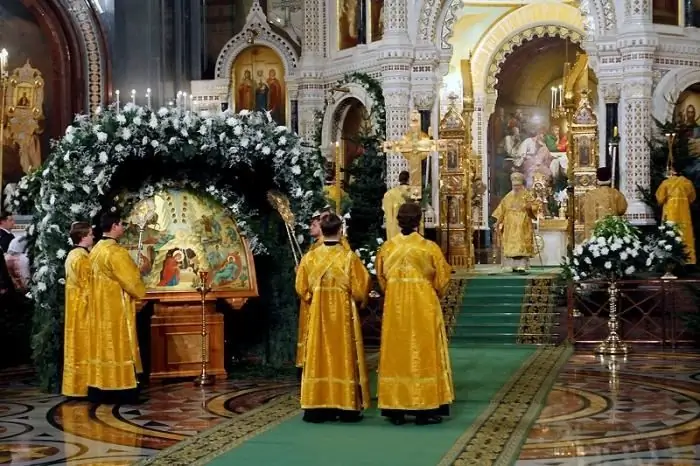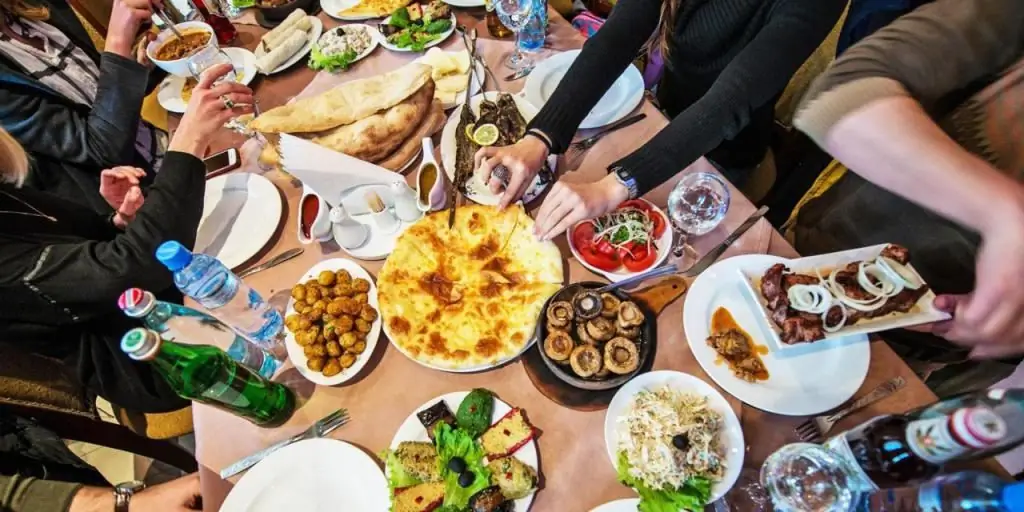2026 Author: Priscilla Miln | [email protected]. Last modified: 2025-01-22 17:55:20
Austria can truly be considered one of the most cultural and musical countries in Europe. The annual Viennese balls, which have no analogues, are known all over the world. Austria over the long years of its existence has managed to feel the cultural heritage of different countries, therefore it is rich in national holidays, which are so brightly and originally celebrated by the inhabitants of this country.
Holidays in Austria: basic information

Most of the Austrians are Catholics, so almost all holidays in this country are based on religion and determined by the Gregorian calendar. For example, out of thirteen public holidays in Austria, ten are religious. It is also worth noting one feature - some holidays are celebrated only in some parts of the country and are established by local law. These events include:
- May 4 - Florian of Lorch Day - is considered the second patron after Leopold, revered by the inhabitants of Upper Austria.
- September 24 is St. Rupert's Day, the patron saint of Salzburg, celebrated by the townspeople for five days. The festivities are accompanied by festivals, fairs and fireworks.
- 10 October - the day of the plebiscite, as a result of which Carinthia became part of Austria.
- November 15 is Saint Leopold's Day, celebrated by the inhabitants of Vienna, who is considered the patron saint of the country.
As for the national holidays in Austria, it should be noted that they are not always associated with fun, there are those whose celebration days the Austrians dedicate to commemorate their deceased loved ones. And in general, celebrations are accompanied by the exchange of gifts, sometimes even purely symbolic trinkets, the arrival of guests, or they are street fairs, balls, festivals and carnivals with bright costumes, masks and boundless enthusiasm.
What are the most popular holidays in Austria?

One of the favorite and widely celebrated holidays of the Austrians are Christmas, New Year and Easter. But the New Year holidays in Austria, as in most European countries, are less popular than Christmas. In anticipation of the celebration of Christmas in the country, lively preparations begin a month in advance, shops and shops begin to work in an enhanced mode, extending opening hours so that not a single one of the residents is left deprived and has time to properly prepare for the celebration. The Vienna Fair, well-known throughout Europe, originating from the medieval years, opens, and from New Year's Eve until the beginning of Lent, the carnival season starts, accompanied bynational festivities and solemnly decorated ancient buildings.
Features of celebrations

Christmas and New Year's still remain purely family holidays. It is customary to serve pork on the festive table on New Year's Eve, goose and carp on Christmas Eve. Of course, each family is rich in its own traditions, but generally accepted dishes in most cases remain unchanged. The most popular New Year's gifts among the inhabitants of Austria are souvenirs from little pigs, chocolate chimney sweeps, marzipan gingerbread and four-leaf clover figurines for good luck, and at Christmas it is customary to exchange pastries and chocolates. Another popular holiday in Austria is Easter, which marks the end of the 40-day Great Lent and is associated with the beginning of spring, light and warmth. Austrians on this day exchange decorated eggs and figurines of hares. This is what concerns world-famous events that are traditionally celebrated by a large number of countries. Let's take a closer look at the brightest and most solemn holidays in Austria, which cause the greatest delight among both local residents and tourists.
Assumption of the Blessed Virgin Mary

In Austria, this holiday is celebrated on August 15 and is considered a public holiday. According to legend, the Blessed Virgin spent the last days of her life in the house of John the Evangelist, who is considered one of the most devoted followers of Christ. Next to her were all the disciples of Jesus Christ, except for Thomas,who arrived only a few days after her death. Thomas desperately asked the apostles for permission to say goodbye to the Mother of God for the last time. Nevertheless, he was allowed to do this, but when the lid of the coffin was lifted for parting, instead of the deceased body, they saw scatterings of flowers. This marked the beginning of the tradition of consecrating bouquets with fragrant herbs in church churches. Bouquets after consecration were brought into the house and hung over the doors and in the prayer corner until the day of the next Assumption, the Austrians decorated their houses with plants and flowers. According to beliefs, the earth during this period is blessed by the Blessed Virgin herself. This tradition is observed to this day, and the legend of the Assumption of the Mother of God is passed down by church servants from generation to generation.
St Martin's Day

The holiday is celebrated on November 11 and is called Martingazel. Along with this event, the annual carnival season traditionally opens in Austria. On this day, the Austrians organize a feast on the occasion of the harvest, the main dish of which is a goose cooked according to a special recipe. In ancient pagan times, this day was the last day of the autumn harvest, hired workers were allowed to go home and, as payment for their work, they were given geese in their hands. This holiday in Austria is still celebrated today according to the established tradition: Austrians visit small restaurants in suburban quiet places where they enjoy the wine of the new harvest, but last year's from this day is already considered old.
Epiphany Day

In Austria, as in many other Catholic countries, the Day of the Epiphany is celebrated on January 6th. Baptism is the day when the three wise men came to the baby Jesus with their gifts. These magi are also called magician kings, hence the second name of the celebration - the Feast of the Three Kings. Now this event is accompanied by a festive service, people bring donations in the form of gold, myrrh and incense. After the service, the Austrians gather at the family table, the main symbol of which is the "Christmas log". Children dress up as three kings and go from house to house, singing songs in the hope of receiving sweets as a reward, for this they draw a talisman against evil spirits on the doors of houses.
All Saints' Day

The celebration falls on November 1 and is considered a public holiday. On this day, memorial rites are performed, which is a sacred duty for every Catholic. The main symbol of the holiday are funeral candles. It is believed that lit candles and the memory of those who left us will help the departed who have fallen into Purgatory, shorten their stay in this gloomy place and accelerate their spiritual purification. The Austrians traditionally visit temples on this day, put candles for the dead, commemorate the drowned with wreaths of fresh flowers floated on the water. In some areas of Austria, people in need are given pieces of bread, and the next day they visit the graves of their departed loved ones.
It is worth noting that these are not all holidays in Austria, but only the most memorable and significant. As for the Austrians themselves, hereOne cannot fail to note their very attitude to the observance of cultural traditions passed down from generation to generation, the unity of the nation on the days of celebrations and love for their culture.
Recommended:
State and national holidays of Armenia

Undoubtedly, all people love the holidays. However, the importance of each of them for an individual may differ. For some people, such a day is an occasion to meet with relatives, for others it is an active holiday with friends, and still others are just waiting for a significant day to sleep, do important things or hobbies. A separate line in the general list of dates are marked in a particular country. Find out which holiday in Armenia is considered the most important today
Public and national holidays in Poland

Most of the holidays celebrated in Poland are religious. Which is not surprising. After all, Poland is a very religious country. But in addition to such celebrations, many national and state holidays, as well as memorable days, are also celebrated here. I would like to talk about all of them in a little more detail
Russian public holidays, their meaning, history and role in modern society

The article provides a brief overview of public holidays in Russia. A brief history of each holiday will help to better understand the origin of a significant date
Mexican holidays (national and religious): list

On the ancient Mexican land, the main religion today is Catholicism. But before the first conquistadors entered this land, their own established beliefs and traditions already existed here. Today, the culture of Mexico is a fusion of the traditions of Christian and folk culture, this explains the wide variety of holidays celebrated in Mexico
Holidays in Georgia: national holidays and festivals, celebration features

Georgia is a country loved by many. Some people admire her nature. Its culture is multifaceted, its people are multinational. There are a lot of holidays here! Some belong only to ethnic groups, they are celebrated on the basis of Georgian traditions. Others represent the heterogeneity of European and Oriental cultures

